Pros: Huge back seat and cargo area for the segment; strong fuel economy; quality interior; functional roof rails
Cons: Bland to drive with numb steering and mushy throttle response; so-so safety scores
The growing number of small SUVs we’ve taken to calling “midcompact” are surprisingly diverse, with each satisfying different niches and providing distinct style. While Volkswagen would probably point to the 2023 VW Taos as a more outdoor adventurey choice thanks to body cladding and functional roof rails, we’d offer instead that it’s the most family-friendly midcompact SUV. The back seat is huge, easily besting all of its midcompact rivals and even some compact SUVs in the segment above. We had no problem fitting a rear-facing child seat in it while maintaining plenty of room for a front passenger. The cargo area, meanwhile, is gigantic for a vehicle of its size — we managed to fit six suitcases and a cooler in the back. Only the Ford Bronco Sport could match it in the segment.
At the same time, this is still a small SUV on the outside. That’s good for fitting in your garage and parking spaces, for fuel economy (which is excellent by the way), and for ensuring a lower price. At the same time, the Taos doesn’t have the same cost-cutting look and feel relative some competitors as well as past made-for-America budget Volkswagens like the Passat and Atlas. You also get more style inside and out than those — this certainly isn’t a bland mom-and-dad mobile.
Well, not in terms of design at least. To drive, the Taos is quite boring with steering enveloped in Novocaine and a throttle pedal that reacts to inputs with all the immediacy of a sloth. It’s really quite the bummer, because if the Taos had control inputs closer to a GTI or even just an ID.4, it would be a real home run. As it is though, the 2023 Taos is still one of the best choices in its niche-filled segment.
Interior & Technology | Passenger & Cargo Space | Performance & Fuel Economy
What it’s like to drive | Pricing & Features | Crash Ratings & Safety Features
What’s new for 2023?
The base model Taos S now comes standard with forward collision warning, automatic emergency braking, blind-spot warning and rear cross-traffic warning. Optional on the S and now standard on the SE is the IQ.Drive package that adds lane-keeping assist and adaptive cruise control. The SEL trim gets a standard panoramic sunroof.
What’s the Taos interior and in-car technology like?
The Taos pulls heavily from the Volkswagen parts bin, which is just fine. The same high-quality switchgear and user-friendly touchscreen interfaces you’ll find in the Tiguan and Atlas are also found in the lower-priced Taos. VW’s Digital Cockpit instrument panel is also standard equipment (8 inches for S and SE, 10 inches for SEL), allowing drivers a wide array of customization options to provide as little or as much information directly in front of you as you desire. Materials quality is comparable to everything in the segment save the near-luxury Mazda CX-30 and Honda HR-V – expect plenty of hard plastics but with a few strategically placed pieces of painted trim and padded leatherette to spruce up the joint. We also like that every trim has some variation of a two-tone color scheme.
There are two infotainment systems available. The base S has a 6.5-inch touchscreen with a more basic interface, but it does include Apple CarPlay and Android Auto. The SE and SEL gain an 8-inch touchscreen (see above), with enhanced functionality plus wireless charging and connectivity for Apple/Android. Both systems are easy to see and reach, and unlike VW’s newer system in the ID.4, GTI and other vehicles, are actually user-friendly. It is utterly confounding how Volkswagen could go from this perfectly agreeable 8-inch touchscreen system to the ID.4’s disaster.
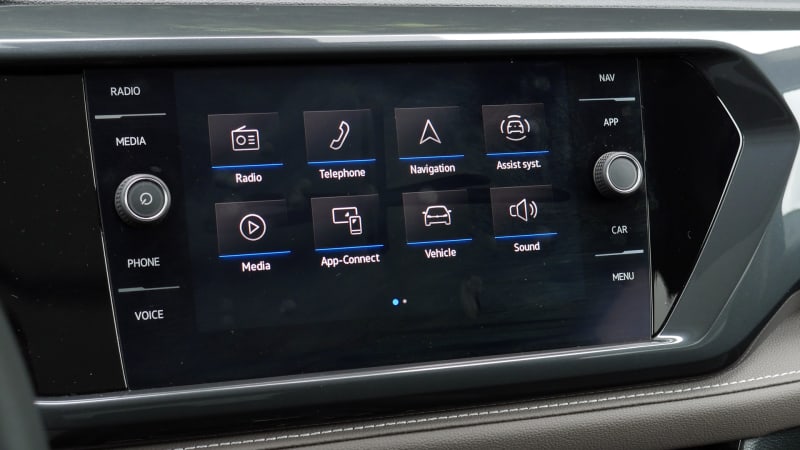
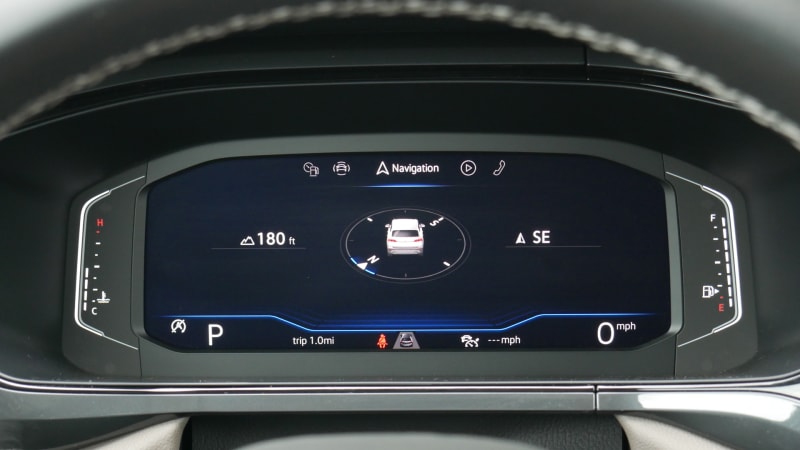
How big is the Taos?
The Taos is a few inches longer than other midcompact SUVs like the Kia Seltos and Mazda CX-30, but is still closer to those than compact models like the Toyota RAV4. You don’t really notice this extra size while driving, but in addition to some smart interior packaging, you absolutely notice it when trying to fit people into the back seat or load up the cargo area.
The back seat is particularly impressive. We were able to fit a giant rear-facing Britax Boulevard car seat and still have plenty of space for a 6-foot-3 passenger up front. That’s rare for any compact SUV, let alone this smaller segment. It also translates into genuine adult-friendly space regardless of who’s up front. The back doors are also quite large.
Cargo space differs slightly depending on whether you get all-wheel drive: it’s 27.9 cubic-feet without it and 24.9 with it due to a higher load floor. With front-wheel drive, the Taos managed to hold more stuff in our luggage test than anything in the segment save for the Bronco Sport. In fact, it was more voluminous than several compact SUVs. We also like that the Taos has raised roof rails, making it easier to swap aftermarket roof racks between cars.
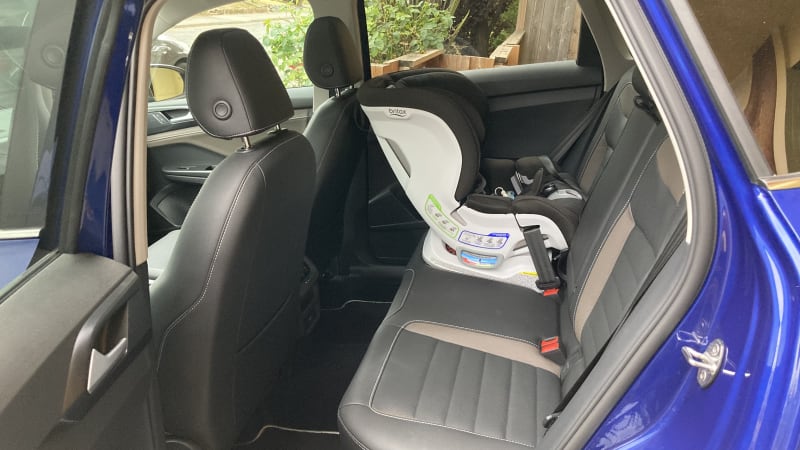

What are the Taos fuel economy and performance specs?
Unlike its competitors, the Taos offers only one engine, but it effectively splits the difference between those rivals’ respective choices. Its 1.5-liter turbocharged inline-four produces 158 horsepower and 184 pound-feet of torque.
Front-wheel drive is standard and is paired with a traditional eight-speed automatic transmission. All-wheel drive is paired with a seven-speed dual-clutch automated manual (aka DSG). Though you may notice some slight differences in their behavior, they’re basically just automatics that shift smoothly as expected. Fuel economy with FWD is 28 mpg city, 36 mpg highway and 31 mpg combined. With AWD those drop to 25/32/28, but the Taos is nevertheless one of the most efficient midcompact SUVs. It’s also worth noting that its total range is over 400 miles.
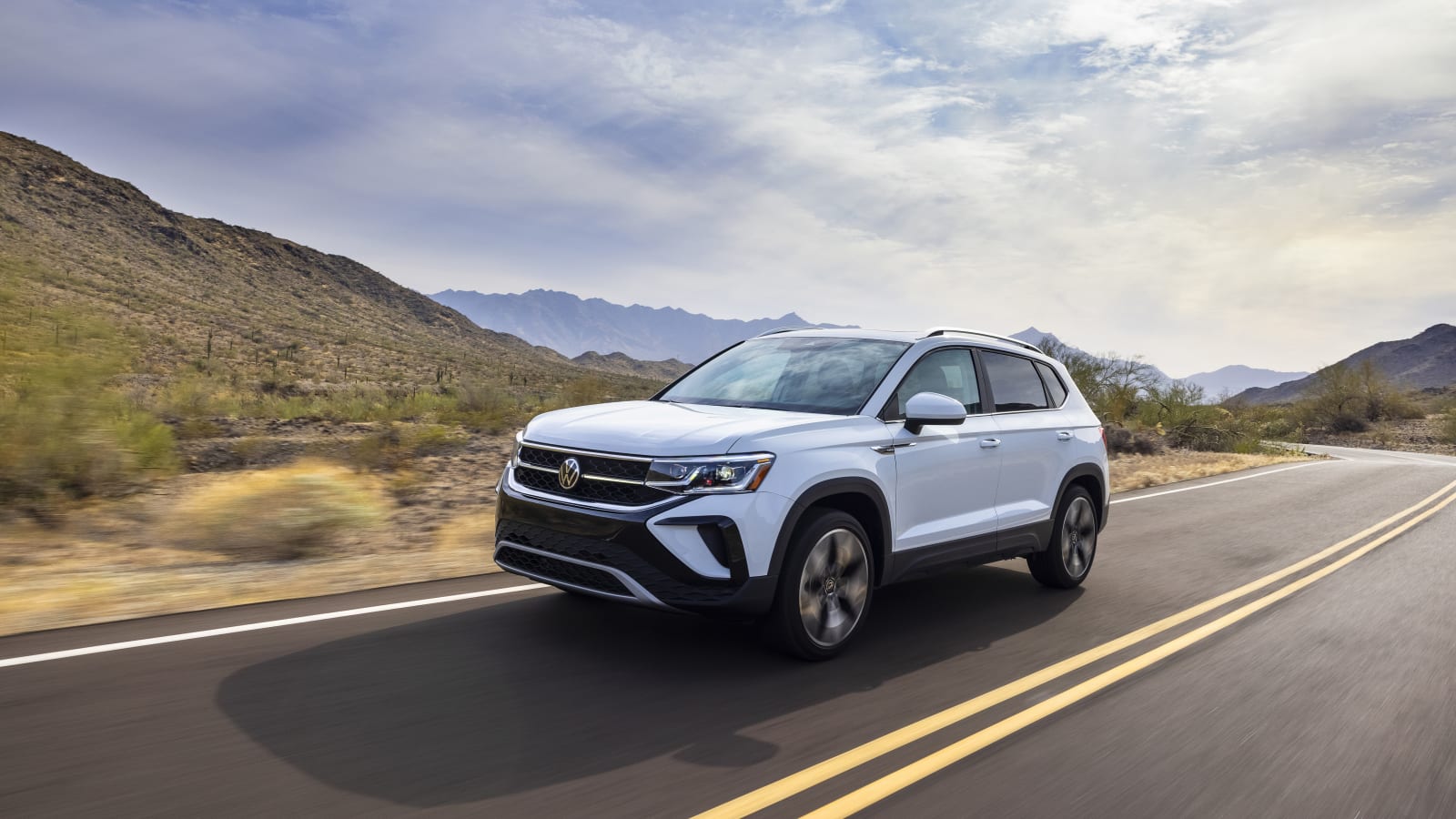
What’s the Taos like to drive?
Despite the front- and all-wheel drive Taos models having different transmissions and rear suspensions, their handling performance, ride quality and powertrain response was similar from behind the wheel. Both versions of the Taos we drove erred on the side of comfort over performance, demonstrating well-controlled responses to bigger bumps and sopping up smaller pavement imperfections with a sophistication expected of a German brand. Its chassis is more than capable of keeping its poise when hustling along a winding road, but Volkswagen’s steering — particularly in the FWD model — prevents you from actually feeling the experience, let alone enjoy it. It’s Novocaine numb on center, then feels like you’re turning elastic bands thereafter. Opting for the AWD model adds drive modes, one of which includes a Sport mode for notably better steering. That said, if you’re looking for a more involving drive, almost anything is a better choice, especially the Kia Seltos and Mazda CX-30.
Also like other Volkswagens, the Taos doesn’t have the sharpest response to throttle inputs. Whether it’s throttle tuning or turbo lag from the small-displacement engine, the result is a car that likes to make sure you really mean it. Similarly, neither transmission is particularly quick about downshifting as needed. Like the steering, this isn’t really a deal breaker, but it does speak to VW’s new compact SUV being more like the Jetta than a GTI.
What other VW Taos reviews can I read?
2022 Volkswagen Taos First Drive Review
Read this more in-depth comparisons between the FWD and AWD Taos versions, as well as the SE and SEL trim levels. We also include more info about its design and engineering.
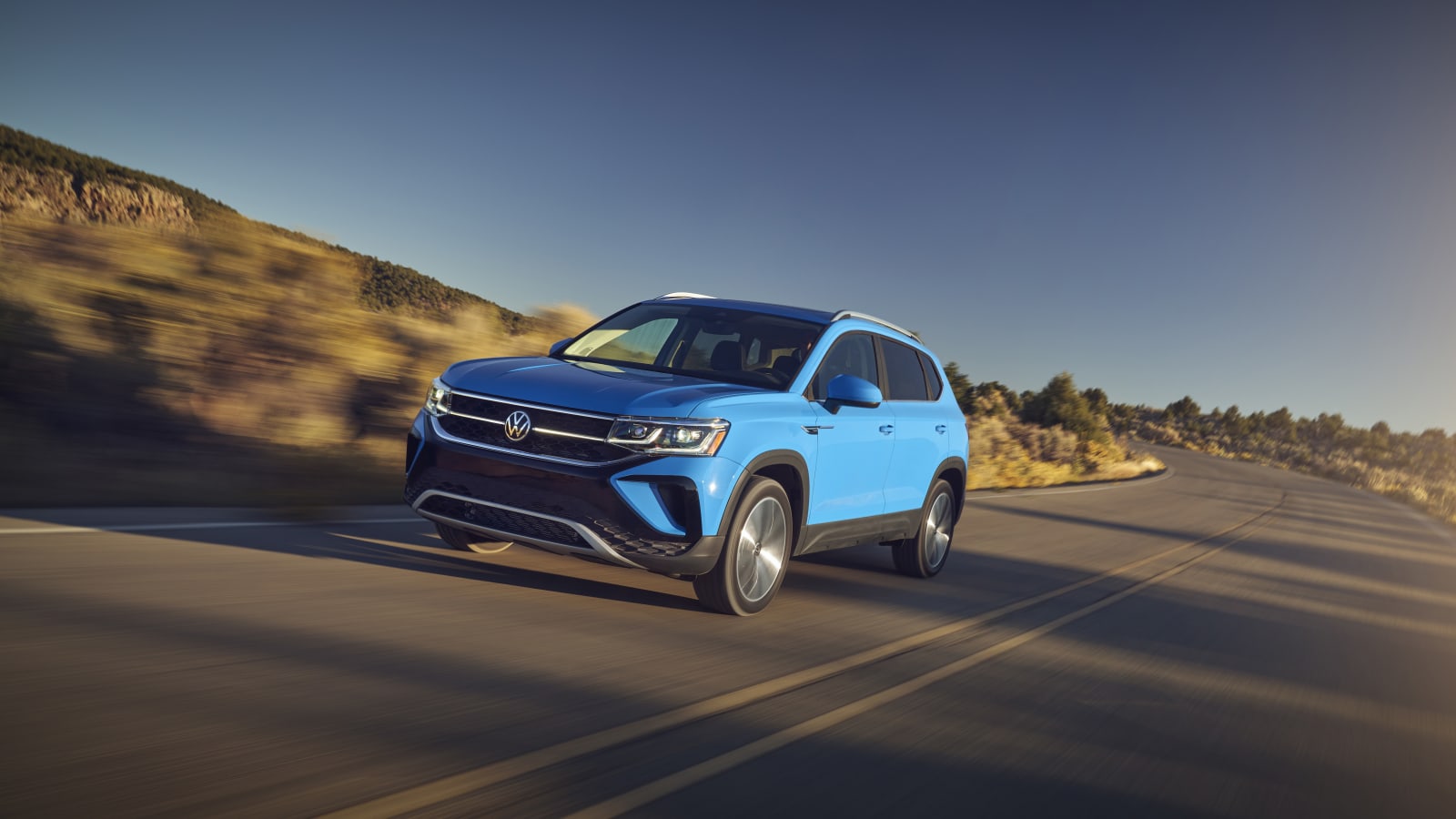
Volkswagen Taos Luggage Test
We take a close look into the Taos cargo area, which actually differs in size depending on whether you get FWD or AWD. We had the FWD one and found that it’s second to only the Bronco Sport in its segment.
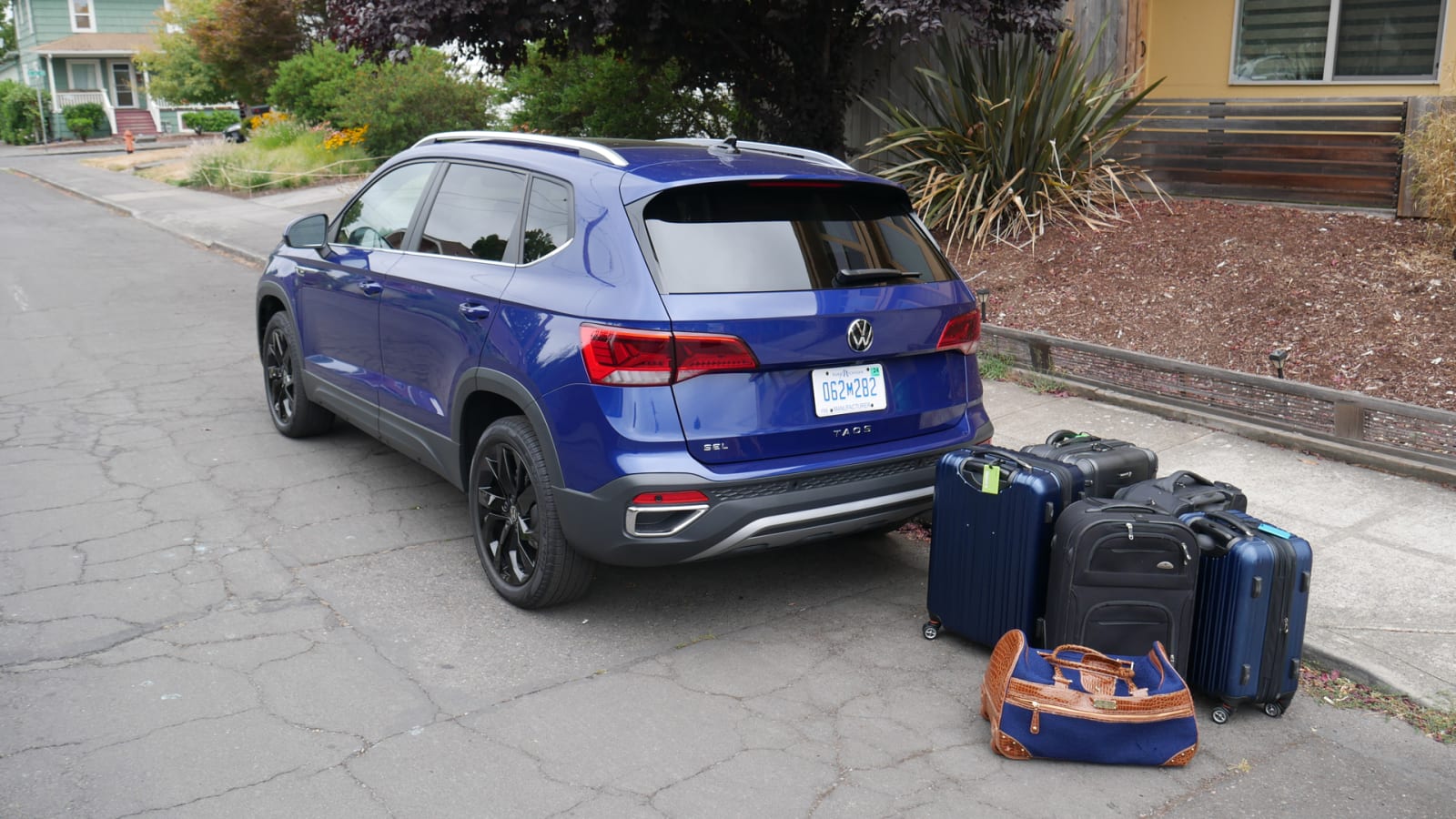
What is the 2022 Taos price and what features are available?
Buying a Taos couldn’t be simpler. There are only three trim levels, two of which are available with front- or all-wheel drive. The SEL is all-wheel-drive only. Pricing is very competitive despite its size, and the fact many assume German cars are pricier than those from other brands. Its starting price of $25,450, including the $1,295 destination charge, is within $1,000 more than the Mazda CX-30, Kia Seltos and Honda HR-V.
Standard equipment includes 17-inch alloy wheels, automatic LED headlights, a manual height-adjustable driver seat, cloth upholstery, heated front seats (w/AWD), an 8-inch Digital Cockpit instrument panel, two USB ports, a 6.5-inch touchscreen interface, a four-speaker sound system and various driver assistance systems described in the safety section below.
Key upgrades for the SE include bigger wheels, proximity entry and push-button start, a leatherette-wrapped steering wheel, upgraded upholstery, an eight-way power driver seat, a rear USB port, an 8-inch touchscreen and a six-speaker sound system. It’s probably the best bet for most.
The SEL’s key upgrades include parking sensors, leather upholstery, a 10.25-inch Digital Cockpit, a panoramic sunroof, in-car navigation and an eight-speaker BeatsAudio system.
S FWD: $25,450
SE FWD: $30,220
S AWD: $29,085
SE AWD: $32,965
SEL AWD: $35,830
What are the Taos safety ratings and driver assistance features?
The NHTSA gave the Taos four out of five stars for overall crash protection, including a four-star frontal rating and five-star side rating. The Insurance Institute for Highway Safety gave it mixed results. It received the best-possible rating of “Good” in most crash tests, but a second-best “Average” in the “small overlap front: passenger side” test and for its head restraints and seats. Its forward collision prevention system got top marks for vehicle-to-vehicle performance, but vehicle-to-pedestrian performance was deemed merely “basic” (a score of 1 on a 0-3 scale). The base headlights were also given a “Marginal” score (Average or Good is needed to be considered for an IIHS Top Safety Pick award), though the SEL’s upgraded lights got a “Good.”
The Taos comes standard with forward collision warning (with pedestrian detection), automatic emergency braking, blind-spot warning and rear cross-traffic warning. Optional on the S and standard on the SE and SEL is the IQ.Drive package that adds lane-keeping assist and adaptive cruise control with stop-and-go capability. The performance of these systems is average for the industry.
Related Video: The newer (worse) VW infotainment system in the ID.4, GTI and more
